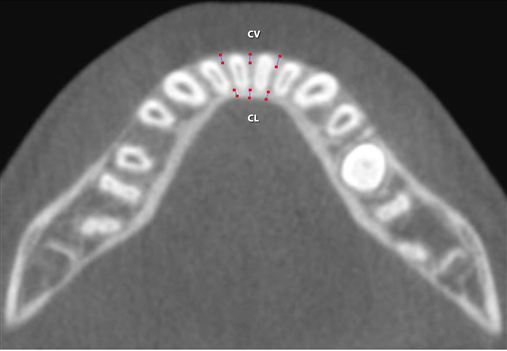Vol. 6 – Número 21 – 2013 Artigo Original/Original article Página 33-40 Avaliação tomográfica da região dos incisivos inferiores após tratamento com o aparelho de Herbst Tomographic evaluation of lower incisors after treatment using Herbst appliance Mércia D. D. Bié1 Alexandre Moro2 Ricardo Moresca3 Gisele Maria Correr4 Estela Maris Losso4 Rodrigo A. P. Gomes1 Resumo O objetivo deste estudo piloto foi avaliar a perda óssea na região dos incisivos inferiores, bem como a inclinação e a protrusão incisal inferior após o uso do aparelho de Herbst para o tratamento da Classe II. Foram selecionados 10 pacientes do grupo controle (G1) com idade média, inicial e final, de 8,9 a 10,4 anos, acompanhados por um período de 18 meses sem o uso do aparelho. E para o grupo tratado (G2) foram selecionados 6 pacientes, com idade média, inicial e final, de 10,8 a 11,4 anos, tratados com aparelho de Herbst com cantilever por um período de 6 meses. Para cada grupo foram realizados dois exames de tomografia computadorizada de feixe cônico (TCFC), T1 inicial e T2 final. Nas TCFC foram avaliadas, na região dos incisivos inferiores, a espessura do osso medular, a espessura das corticais vestibular e lingual, e a protrusão e a inclinação dos incisivos inferiores, utilizando o software InVivo 5.0. Os dados foram submetidos à análise estatística (análise de covariância e test t) com nível de significância de 5%. Como resultado, observou-se que a cortical vestibular na região entre os dentes 41 e 42 mostrou um aumento significativo no grupo controle (0,30 mm). A espessura da cortical lingual mostrou uma alteração significativa apenas no grupo controle na região entre os dentes 32 e 31 (0,46 mm). Para a medição da protrusão do incisivo inferior, houve uma diminuição dos valores, que foi significativa apenas para o grupo controle (-0,79 mm). Pode-se concluir que o aparelho de Herbst com cantilever não provocou perda óssea nas corticais vestibular e lingual. Durante os 6 meses iniciais de utilização do aparelho houve uma pequena vestibularização e protrusão anterior dos incisivos inferiores, sem implicações clínicas relevantes. Descritores: Má oclusão, Classe II, perda óssea alveolar, tomografia. Abstract The aim of this pilot study was to evaluate bone loss in the region of the lower incisors and the incisal inclination and protrusion after Class II treatment with Herbst appliance.10 patients from the control group (G1)with initial and final mean ages of 8.9 to 10.4 years were selected and followed by a period of 18 months with out the use of the device. For the treated group (G2), 6 patients with initial and final mean ages of 10.8 to 11.4 years were treated with Herbst appliance with cantilever for a period of 6 months. Two cone beam computed tomography (CBCT) exams were carried out for each group, before treatment (T1- initial) and after 6 months (T2 – final). Through CBCT images from the region of the lower incisors, were evaluated the thickness of the bone marrow, the thickness of vestibular and lingual cortical, and protrusion and inclination of lower incisors, using the software In Vivo 5.0. Data were submitted to statistical analysis (analysis of covariance and T test) with a significance level of 5%. As a result it was observed that the cortical bone in the region between the teeth 41and 42 showed a significant in crease on the control group patients (0.30 mm). The thickness of the lingual cortical presented a significant change only in the control group on the are a between teeth 32 and 31 (0.46 mm). Regarding the protrusi on of the lower incisors, there was a decrease of values which was significant only for the control group (-0.79 mm). It can be concluded that the Herbst appliance with cantilever does not cause bone lossin vestibular and lingual cortical. During the initial 6 months of treatment, there was a small vestibular inclination and anterior protrusion of the lower incisors with out relevant clinical implications. Descriptors: Malocclusion, Class II, alveolar bone loss, tomography. 1 Aluno do Programa de Mestrado em Odontologia Clínica –Universidade Positivo. 2 Prof. Ass. – UFPR – Graduação e Pós-graduação em Ortodontia, Prof. do Programa de Mestrado em Odontologia Clínica – Universidade Positivo. 3 Prof. Adj. da UFPR – Graduação e Pós-graduação em Ortodontia, Prof. do Programa de Mestrado em Odontologia Clínica – Universidade Positivo. 4 Profa. do Programa de Mestrado em Odontologia Clínica – Universidade Positivo.
Este conteúdo é restrito a membros do site. Se você é um usuário registrado, por favor faça o login. Novos usuários podem registrar-se abaixo.
LEIA MAIS

